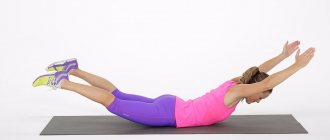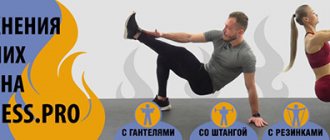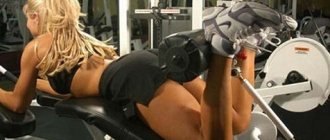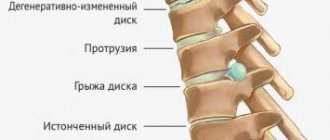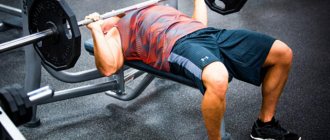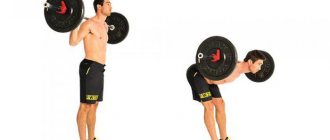- We do it right.
How to achieve beautiful posture and get rid of unpleasant pain in the lumbar region? Be sure to include the cat exercise for your back in your personal training program. This is one of the simplest elements, but if performed correctly, you can achieve unprecedented results by improving your body health and working important muscle groups.
If you have been suffering from back pain for a long time and want to improve your posture, start arching and bending correctly.
Features of the “Cat” exercise
It was originally used in yoga. Now quite common in fitness and physical therapy. The peculiarity of the “Cat” or “Dog” exercise (a less common name) is that it can safely and effectively affect the entire body. Firstly, with the help of this exercise you can reduce pain in the back. Secondly, the “Cat” exercise for the spine has a beneficial effect on the functioning of the respiratory system. Therefore, those who often suffer from bronchitis or who have a weakened immune system are also recommended to pay attention to “Kitty”.
Beneficial properties of the exercise
Of course, when performing any set of exercises, you are primarily interested in the effect it gives. The “Cat” exercise has a number of advantages. Which ones? More about this below.
- Relieves back pain. Those who suffer from pain simply need to do this exercise. Due to the uniform load on the back muscles, which are subject to active movement, pain is reduced.
- Recommended for pregnant women. "Cat" has a double effect. Combining both breathing exercises and healing properties, that is, gradual muscle stretching, the “Cat” exercise for pregnant women is one of the recommended ones.
- The “cat” helps tighten the abs. Along with relieving pain, the exercise has another property that will be very appealing to those who want to have a toned tummy. The fact is that when performing the “Kitty” exercise, a person’s abdominal muscles are always tense. The exercise itself does not require any special body movements. In other words, you can get graceful abs on your stomach without straining.
- Helps relax the spine and neck. So much has been written about the dangers of a sedentary lifestyle, but nevertheless, people are in no hurry to follow doctors’ recommendations and diversify their lives with exercise. But problems in the cervical-vertebral region arise precisely because of this. Performing the “Cat” exercise helps stretch the muscles and ligaments in the neck and back.
- The exercise can be performed by both experienced athletes and beginners. “Kitty” is not a difficult task. It does not require any special devices, so it can be performed in any conditions. Due to this, the exercise is suitable for both athletes and beginner amateurs. The only thing that needs to be observed is to regulate the load in accordance with the characteristics of your body. The “Cat” exercise for children is also recommended.
- Increases the endurance of the body as a whole. Despite the simplicity of the exercise, a huge number of muscle groups are involved in its various variations. The usual pattern applies here: the more parts of the body we use at the same time, the greater the impact. Working together, the muscles exert enormous pressure on the entire body. And so the natural consequence is that his endurance and resilience increases.
- Increasing the speed and quality of metabolic processes. Due to the special technique of performing the exercise, our body is saturated with oxygen. As a result, blood begins to circulate faster, and nutrients reach the necessary organs more quickly.
The benefits of "cat"
If you lead a sedentary lifestyle, “cat” should definitely be included in a set of exercises to develop flexibility, etc. The benefits are enormous:
- The exercise helps in working out the spinal column. All, even deeply located, back muscles are perfectly worked out - pain and heaviness that occurs during active movements are relieved. No medication is needed to relieve discomfort.
- Improved flexibility of the neck, back and shoulder girdle.
- This is an excellent start to any day and prepares the body for more serious loads - tension of skeletal muscles, saturation and acceleration of blood throughout the body, activation of lymph, and removal of toxins.
- Prevention of respiratory diseases, development of rhythmic breathing.
- Acceleration of metabolism. The fat burning process not only starts, but also accelerates to the limit.
- Relieving muscle tension and fatigue.
Note. This movement is especially recommended during pregnancy. It perfectly relieves the lumbar region and effectively massages the abdominal area.
There is nothing difficult in doing the exercise. It copes with its tasks perfectly, while being accessible to people in any physical form.
How to do the exercise correctly?
Take your starting position.
- To do this, you need to get on the mat on all fours.
- Arms should be extended, palms pressed firmly to the floor surface. Fingers point forward.
- Bend your legs at a right angle. Make sure the load is evenly distributed between your knees and palms.
After taking the correct position, you can begin the exercise.
- Exhale deeply while drawing in your stomach. Arch your back upward, lower your head. Try to stretch your back up as high as possible. Make sure your abdominal muscles are tense.
- Remaining in this position, count to eight. After taking a deep breath, slowly return to the starting position. Relax.
- Inhale again. But this time arch your back in the opposite direction. The head should be raised. The pectoral muscles and abdomen are stretched during this process.
- Also, after counting to eight, exhale and return to the starting position.
Repeat the "Cat" exercise for the back 5-10 times. Let's consider another option for performing “Cats” in the classical variation.
To perform the exercise, get on all fours, while leaning on your palms and knees. Lowering your head and pelvis down, arch your lower back upward. Remaining in this position, count to ten. Then lower your pelvis onto your heels. Your arms should remain extended on the floor. Rest your head on your hands, doing an asana, which in yoga is called child's pose. Relax. Do two or three repetitions.
Contraindications
If you perform knee-elbow gymnastics correctly, then it has no absolute contraindications. If you experience any discomfort, dizziness or headache during exercise, you should immediately change your position. To avoid discomfort, it is necessary to increase the load gradually. You should start by maintaining the position for 5 minutes, then you should gradually increase the duration to 15-30 minutes.
Limitations to the exercise are spinal injuries that do not allow flexion and extension of the back. Care must also be taken in case of neck injuries - do not include it in the process, leaving it in line with the spine. If you feel severe discomfort, you should consult a doctor.
Attention! A significant advantage is the absolute absence of contraindications for performing this exercise. On the contrary, for severe back pain it is recommended to perform it daily.
However, there are several moments when it is impossible to perform not only this exercise, but also any other load. These are:
- Bad feeling.
- Unpleasant sensations, pain, inflammatory reactions in the joints (knee, elbow).
In these cases, you should immediately consult a doctor.
Tips and tricks for doing the exercise
First, about the general rule. When performing any back exercise, the actions should be smooth. Everything is done at a slow pace. No jerking! The correct position in the exercise is important.
The starting position implies a clear position of the knees parallel to the pelvis, and the palms parallel to the shoulders. The abdominal muscles should be tense throughout the exercise.
- To better arch your back, lift your head as high as possible.
- As you arch and arch your spine, hold the position for about eight to ten seconds.
- When tilting your head down, try to point it as close to your elbows as possible.
- It is best to perform the “Cat” exercise on an empty stomach. You can do it every morning. If you train in the evenings, then wait a few hours after eating and then start exercising.
Yoga for pregnant women
Sports during pregnancy are becoming increasingly popular, and especially yoga or, as it is also called, gymnastics for pregnant women. The exercises included in this complex strengthen the nervous system, help master special breathing, and strengthen the abdominal muscles and birth canal. These activities will have the best impact on the health and physical condition of the pregnant woman, as well as on how childbirth will proceed. When doing gymnastics for pregnant women, childbirth proceeds easier and faster, and complications are observed less frequently.
But not everyone who wants to do yoga for pregnant women has the opportunity to attend classes for some reason, perhaps financial, and often there are simply no sports organizations or sections in the city or in a particular area where they would be held. But this is not a problem, the main thing is desire. Next, we will publish several popular exercises that can be performed at any stage of pregnancy. You can do these exercises at home. Turn on some nice relaxing music, get some privacy and you can start exercising.
Exercise 1. Strengthening the gluteal muscles.
We stand with our feet shoulder-width apart, knees slightly bent. We put our hands on our hips and begin smooth swaying of our hips - right and left. We do the exercise 10 times in each direction. We stopped. Now the same smooth rocking of the pelvis - back (inhale), forward (exhale). We also perform the exercise 10 times in each direction. We stopped. Next, we make circular movements, the knees are also slightly bent, try to make a full circle, take your time. There are 5 full circles in one direction and the same in the opposite direction. Perform movements slowly and relaxed.
Exercise 2. Strengthening the legs and gluteal muscles.
Arms crossed on the chest, feet parallel to each other shoulder-width apart, knees slightly bent, back straight. We begin slow squats. Down - inhale, up - exhale. With this exercise we train the leg muscles and gluteal muscles. 10 slow squats, 10 squats at a pace, that is, we speed up the exercises by 2 times. Be sure to control your breathing.
Exercise 3. Strengthen the inner thighs.
We turn our feet, toes apart, heels forward, knees slightly bent, pelvis forward, buttocks tense. We begin slow squats. This is an exercise for the inner thighs. Slowly squat down, thighs parallel to the floor. Down - inhale, up - exhale. 10 slow squats, 10 at tempo. Control your breathing, keep your back straight.
Exercise 4. Strengthening the muscles of the arms and chest.
We stand in a knee-elbow position, that is, on all fours. Palms under shoulders at knee level, feet on the floor, shins parallel to each other, back straight. We begin push-ups, bending our elbows to the sides. Down - inhale, up - exhale. We don’t stop in the final positions, we don’t straighten our arms at the elbows, we don’t hold our breath. This exercise trains the muscles of the chest and arms. We perform 20 push-ups.
Exercise 5. “Dog Pose.” Learning to relax your muscles.
Having finished the previous exercise, we connect our feet, knees apart, leaving room for the tummy, pelvis to the feet. Extend your arms in front of you and slowly tilt your head between them towards the floor. This pose is called relaxation pose, or dog pose. Relax the muscles of the neck, shoulders, back, legs.
Exercise 6. “Cat Pose.”
We strengthen the muscles of the arms and back, stretch the rectus abdominis muscles. We come out of the dog pose again into the knee-elbow position. Palms under shoulders at knee level, knees hip-width apart, shoulders down, lower back up. Now we will master the cat pose. Slowly bend in the lower back, head up - the “happy cat” pose, stretch the rectus abdominis muscles, fix the position for 10 seconds. We begin to work with our hips, in one direction and the other, 5 times each. Then we make circular movements with our hips - 5 full circles in each direction. Slowly bend your back upward, head down - “angry cat” pose, fix the position for 10 seconds. We begin to alternate poses - “angry cat”, “joyful cat”. We alternate 5 times each, try to do everything slowly, don’t rush.
Exercise 7. “Kegel exercise.” Strengthening the pelvic floor muscles.
This exercise is called the Kegel exercise, you may have already heard about it. From the kneeling pose, we sit on the soles of our feet. We strain the gluteal muscles and everything that can be strained inside as hard as possible, and then relax. We tense again, relax. We continue to do this exercise. You feel that you can tense the internal muscles, these are the pelvic floor muscles, the birth canal through which your baby will pass. Tighten them as you exhale, and relax them as you inhale. Do this exercise 20-30 times, the more the better.
Do these exercises every day, it won't take you much time, but it will give you good results. After yoga exercises, it is advisable to lie down, relax, on your back for a few minutes, and then go for a walk in the fresh air. If this is not possible, then just stay in a well-ventilated area. This is only part of the complex, but it can also prepare your body for childbirth.
Common Mistakes
When performing the exercise, you need to listen to your body. With the correct technique, there should be no pain in the neck and spine. If you feel pain, you should stop exercising.
- Jerking is another common mistake. Making sudden movements can cause serious injury to the vertebrae.
- Bent knees and elbows. When performing the exercise, your arms should be straight. And the knees of the legs should form a right angle with the shins.
- When describing the exercise, it is indicated when it is necessary to inhale and exhale. Failure to comply with these rules is also quite common. The fact is that sagging restricts the flow of air from the lungs. So before you do the backbend, take a deep breath.
- No need to throw your head back. First of all, there is no need to do this at all. And secondly, you risk getting a neck injury.
How are knee-elbow exercises useful during pregnancy?
This position is usually prescribed to all women, including those who have problems with pregnancy. An actively growing uterus puts pressure on the organs of the chest and abdominal cavities, disrupting their normal functioning.
This position helps to relax the walls of the uterus (improves its activity during childbirth), reducing its pressure on the pelvic organs (bladder, rectum), which reduces the severity of edema.
Indications:
- Disruption of the pelvic organs.
- Exacerbation of osteochondrosis.
- Impaired blood circulation of the placenta.
- Varicose veins of the lower extremities and rectum.
- Disruption of the cardiovascular system.
- Incorrect presentation of the fetus.
This exercise can be performed by completely healthy women; the exercise improves well-being and prepares the uterus for childbirth .
Below is a visual and informative video about the benefits of the knee-elbow pose:


